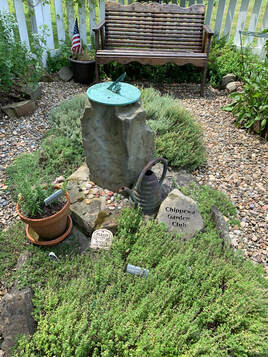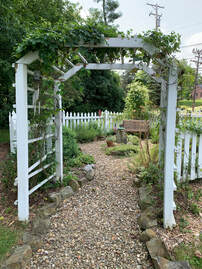The Squire Rich Museum Herb Garden

Sundial and wooden bench
History of the Garden:
The Chippewa Garden Club has maintained an herb garden at Squire Rich since 1982. Originally it was an 11-foot-square raised bed that contained primarily medicinal herbs that the pioneers settling in Brecksville would have used in the mid-1800s.
In 2003, the Garden Club recognized the need to refurbish the garden. The timbers bordering the raised bed were rotting, and the sidewalk along the bed was cracked and heaving. The herb committee within the Garden Club began visualizing what a “new” pioneer garden might look like and set out to raise the necessary funds to implement that vision.
In 2004, they began by excavating the old bed, and, with the help of the Metroparks, lined a new 20 ft. x 20 ft. area with stones (siltstone) from the Cuyahoga river valley. Because of the Metroparks hard and careful work, the sun dial and a previously buried millstone became the focal point of the garden. The garden was fenced using decorative, scalloped pickets -- an indication that the Squire was an important and affluent citizen of Brecksville.
In 2006 an Amish constructed wooden bench was installed, donated by both the Brecksville Historical Association and the Chippewa Garden Club, in memory of past members of both organizations who loved horticulture. The garden was again renovated in 2014. Stephen Losi, as part of his Eagle Scout project, repaired fence pickets and portions of the arbor where Northeast Ohio winters had taken their toll. He also installed a new foundation stone beneath the sundial, stones along the path, and a mulched border along the outside fence.
The Chippewa Garden Club has maintained an herb garden at Squire Rich since 1982. Originally it was an 11-foot-square raised bed that contained primarily medicinal herbs that the pioneers settling in Brecksville would have used in the mid-1800s.
In 2003, the Garden Club recognized the need to refurbish the garden. The timbers bordering the raised bed were rotting, and the sidewalk along the bed was cracked and heaving. The herb committee within the Garden Club began visualizing what a “new” pioneer garden might look like and set out to raise the necessary funds to implement that vision.
In 2004, they began by excavating the old bed, and, with the help of the Metroparks, lined a new 20 ft. x 20 ft. area with stones (siltstone) from the Cuyahoga river valley. Because of the Metroparks hard and careful work, the sun dial and a previously buried millstone became the focal point of the garden. The garden was fenced using decorative, scalloped pickets -- an indication that the Squire was an important and affluent citizen of Brecksville.
In 2006 an Amish constructed wooden bench was installed, donated by both the Brecksville Historical Association and the Chippewa Garden Club, in memory of past members of both organizations who loved horticulture. The garden was again renovated in 2014. Stephen Losi, as part of his Eagle Scout project, repaired fence pickets and portions of the arbor where Northeast Ohio winters had taken their toll. He also installed a new foundation stone beneath the sundial, stones along the path, and a mulched border along the outside fence.

Take a Garden Tour:
The garden was planted in 2005 after extensive research that led to Lebanon Springs, New York, where the Rich family came from. That area is famous for a Shaker Herb Farm, Mount Lebanon, whose 1851 plant list was still available. The Garden Club reasoned that any herb on that list could have been brought west. There are historical records that indicate Jane Rich, the Squire’s wife, was a practicing herbalist. Details are lacking, but it is known that she had an herb garden on the property. From the over 300 selections available, approximately 30 herb varieties were selected for inclusion in the garden.
The garden was planted in 2005 after extensive research that led to Lebanon Springs, New York, where the Rich family came from. That area is famous for a Shaker Herb Farm, Mount Lebanon, whose 1851 plant list was still available. The Garden Club reasoned that any herb on that list could have been brought west. There are historical records that indicate Jane Rich, the Squire’s wife, was a practicing herbalist. Details are lacking, but it is known that she had an herb garden on the property. From the over 300 selections available, approximately 30 herb varieties were selected for inclusion in the garden.

Hop Plant
As you pass through the arbor, notice the hops growing on either side. No, there’s no brewing going on — however, many pioneers did! The blossoms can become a simple flower arrangement or can be used to induce sleep, a documented medicinal attribute of hops.
The center of the garden is the sundial surrounded by several thyme varieties. The sundial keeps perfect time —once you account for daylight savings time, if necessary! The sundial was the focus of the original garden and is dedicated to the wife of a descendant of the Squire.
Moving counterclockwise along the path you can visit the culinary garden, the tea garden and the fragrance garden. At the southwest corner, downwind of the fragrance garden, is where the bench is placed. Climbing on the trellis behind the bench is the clematis “Henri” and the native autumn blooming clematis. Henri is a clematis cultivar dating back to the mid 1800s.
The south bed is entirely devoted to medicinal herbs, which were quite critical to the pioneers. Finally, on the eastern side you’ll find a native flower garden. These wonderful plants were here when the pioneers arrived....beauty is a useful reason to have them in an herb garden!
The center of the garden is the sundial surrounded by several thyme varieties. The sundial keeps perfect time —once you account for daylight savings time, if necessary! The sundial was the focus of the original garden and is dedicated to the wife of a descendant of the Squire.
Moving counterclockwise along the path you can visit the culinary garden, the tea garden and the fragrance garden. At the southwest corner, downwind of the fragrance garden, is where the bench is placed. Climbing on the trellis behind the bench is the clematis “Henri” and the native autumn blooming clematis. Henri is a clematis cultivar dating back to the mid 1800s.
The south bed is entirely devoted to medicinal herbs, which were quite critical to the pioneers. Finally, on the eastern side you’ll find a native flower garden. These wonderful plants were here when the pioneers arrived....beauty is a useful reason to have them in an herb garden!
Today in the Garden:
There are currently over 30 different kinds of herbs planted within the herb garden and the garden is open for sniffing, touching, and harvesting 24/7. You can walk through the garden with a Chippewa Garden Club member at either the Corn Roast or Apple Butter Festivals held in August and October each year. You can also arrange for a private tour for yourself, your family, or your organization. Contact Jo Ann Bartsch at 440-740-0034 or by e-mail (jabartsch@att.net) to make arrangements.
Chippewa Garden Club members generally work in the garden every Friday morning during the growing season. Visitors with trowels or clippers in hand are certainly welcome to help and harvest! It's been over 35 years and the Chippewa Garden Club and the Brecksville Historical Association have remained true to initial purpose and theme for the garden:
“If you would have a lovely garden, you should have a lovely life.”
(The Gardener’s Manual, 1843, New Lebanon, NY)
There are currently over 30 different kinds of herbs planted within the herb garden and the garden is open for sniffing, touching, and harvesting 24/7. You can walk through the garden with a Chippewa Garden Club member at either the Corn Roast or Apple Butter Festivals held in August and October each year. You can also arrange for a private tour for yourself, your family, or your organization. Contact Jo Ann Bartsch at 440-740-0034 or by e-mail (jabartsch@att.net) to make arrangements.
Chippewa Garden Club members generally work in the garden every Friday morning during the growing season. Visitors with trowels or clippers in hand are certainly welcome to help and harvest! It's been over 35 years and the Chippewa Garden Club and the Brecksville Historical Association have remained true to initial purpose and theme for the garden:
“If you would have a lovely garden, you should have a lovely life.”
(The Gardener’s Manual, 1843, New Lebanon, NY)




